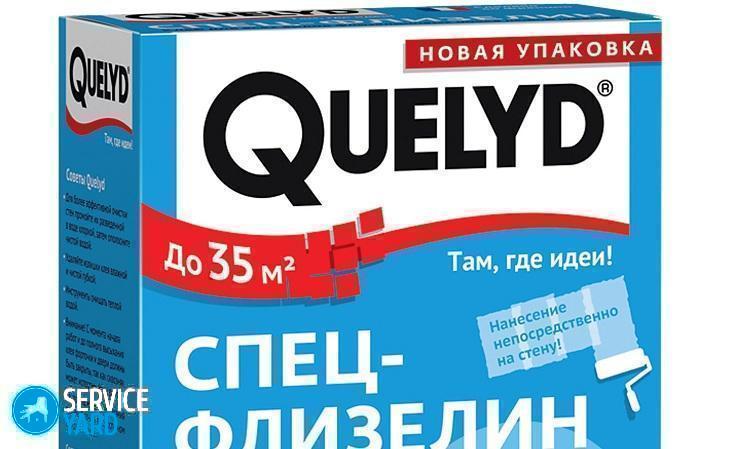Adhesive for non-woven wallpaper

Self-repair in an apartment or a private house is a problem that probably everyone had to face. One of the innovative wall coverings is non-woven wallpaper. They are beautiful and functional. Unlike ordinary paper wallpapers, they can be painted several times. Finishing material is quite massive, so glue must be chosen with good adhesion, holding the canvas on the wall. Consider how to choose the right glue for non-woven wallpaper, find out what requirements the composition must meet.
to contents ↑Requirements
Adhesive for wallpaper on a non-woven basis must meet the following requirements:
- Quick dissolution, ease of use.
- Well-defined grip effect.
- Easy to apply.
- Thickness, allowing you to stay without problems on a vertical surface.
- Colorlessness.
- No stains when completely dry.
- Chemical neutrality to dyes.
- Environmental Safety.
- Antiseptic and antifungal effect due to special additives.
- Economical spending.
Types of non-woven coatings
Such wallpapers keep excellently on plastered, concrete, wooden, foam concrete and plasterboard walls.
Distinguish single and double layer non-woven wallpaper:
- In a single-layer material, there is no additional coating.
- The two-layer ones, in addition to the base made of non-woven fabric, have a decorative coating.
to contents ↑Important! Naturally, the greater the thickness of the coating, the more glue will be needed. On average, about 0.8 kg of finished glue is obtained from 0.8 kg of dry mix. This is enough for 66 square meters of wallpaper.
Non-woven wallpaper glue - which is better?
There are 2 types of adhesive compositions:
- Universal, which can be used for different types of coatings.
- Special (specifically for non-woven coatings).
Important! If you prefer the universal option, then you need to choose a composition for heavy types of wallpaper (vinyl, acrylic). Ideally, if glue and wallpaper are products of the same company. In this case, you should not worry about the result - the manufacturing company has provided all the nuances of this material.
So, glue for non-woven wallpaper - which is better? The most popular is the products of companies:
- KLEO.
- Quelyd.
- Metylan
Quelyd is the best glue for non-woven wallpaper:
- An important advantage of this composition is the ease of application to the walls with a brush or roller.
- The solution has excellent glide, sticking the panels joint to joint can be done without much difficulty.
- The glue is environmentally friendly, it does not contain hazardous substances.
- After drying, it does not interact with cement or dye.
- Thanks to special additives, the surface becomes unattractive to the fungus.
- Preparing the mixture is a pleasure, the work progresses quickly. Quelyd's glue resembles flakes in appearance. The basis of the composition is modified starch. The solution is ready for use 10 minutes after mixing. In its finished form, it is colorless, does not leave any traces on the surface.
Important! It is recommended to glue surfaces at an air temperature of 5 to 25 degrees. The towels are held on the walls very firmly, but if necessary they can be removed without any problems.
The shelf life of dry matter is unlimited.Ready-made glue for non-woven wallpaper of this brand, when stored in a closed vessel, can be used within a week.
Important! The time for complete drying of the glue is from one day to two. 1 pack (0.3 kg) is consumed per 35 “squares” of surface.
Metylan:
- Metylan glue is perfectly compatible with cement and bleached lime surfaces, resistant to temperature extremes.
- The mixture gives a stable grip; correction is possible during gluing. Antifungal supplements are available.
- Like the previous brand, Methylan glue is made on the basis of modified starch.
- Can be used for smooth and embossed wallpapers.
Important! If the non-woven wallpaper is prepared for painting, it is advisable to use “Methylan Premium” glue, which can withstand high humidity.
- The amount of dry mix in the package is 0.25 kg, it is diluted in 10 liters of water. This is enough for 70-80 “squares" of surfaces.
- Shelf life of the dry mixture is 3 years, the finished solution should be used immediately.
Important! The air temperature in the pasted room should be 20-30 degrees.
Cleo
This glue is used for different types of “non-woven fabric”. The mixture contains antifungal additives, it does not contain substances hazardous to humans and animals. There are several types of glue produced under this brand:
- KLEO Line Professional is a mixture based on methyl cellulose, modified starch and special additives. Recommended for professional use, guarantees high-quality gluing in a short time.
- KLEO Line Optima - provides simple, quick and high-quality wall gluing, helps to hide minor flaws made during installation, does not leave spots.
- KLEO Line Special - adhesive on methylcellulose, providing good adhesion. Suitable for any wallpaper of various densities.
to contents ↑Important! A total of 0.25 kg of dry mix per pack A ready-to-use composition is sufficient for pasting 30 “squares" of surfaces.
How to cook glue?
This is a very simple task, but certain rules must be observed. Here is the procedure:
- Pour the contents of the bag into an enameled pan or bucket.
- Pour dry glue with water, according to the instructions. Water is cold or at room temperature.
- Stir the glue, leave it to settle - the specific time is indicated on the package.
- Stir the mixture again. The glue is ready to use.
Useful Tips
All varieties of wallpaper glue described in the article provide high-quality gluing. However, a lot depends on how you prepared the walls for gluing wallpaper panels:
- Before gluing, wash the walls in 2 stages: first, with chlorinated and then with dechlorinated water.
- Apply glue only to walls. Do not smear wallpaper towels, as it can lead to excessive and irrational use of the adhesive.
- In any case, the walls must be cleaned of dirt before gluing, otherwise no glue will help.
- In order for the adhesive to lay evenly, the walls must first be primed.
Important! Using an acrylic primer not only improves the quality of work, but also the most wallpaper glue is consumed 20% less.
- Spread only that part of the wall on which you are going to stick the cloth. If you glue too much area with glue, it will dry quickly and the material will be wasted.
- When attaching the panel, do not forget to remove excess glue. If you leave streaks, they will interfere with normal staining.
- In the room where the work is going on, drafts should not be allowed.
Stock footage
What glue to glue non-woven wallpaper, which brand to give preference? Of course, it is advisable to choose a specialized composition designed specifically for this type of finishing material. If you follow these simple rules, repair will turn from a time-consuming routine into a pleasure.
- How to choose a vacuum cleaner taking into account the characteristics of the house and coatings?
- What to look for when choosing a water delivery
- How to quickly create comfort at home - tips for housewives
- How to choose the perfect TV - useful tips
- What to look for when choosing blinds
- What should be running shoes?
- What useful things can you buy in a hardware store
- Iphone 11 pro max review
- Than iPhone is better than Android smartphones




